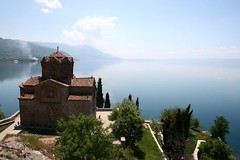
We woke up in our panel-house apartment, equipped, among other things, also with the collected works of Josip Broz Tito. Nikola stopped by to arrange the plans for the upcoming days. He took us to see Plaoshnik, on the top of the hill above the old town, where the monastery of St. Kliment and the first Slavic university founded in the 9th century used to stand.
The entire surroundings of the church of St. Kliment were now turned into a large archeological excavation site, and we could see the newly revealed mosaics or bone remains in a burial ground. Saint Kliment and and Saint Naum, who founded the university, were disciples of St. Cyril and St. Metodus. Only during the life of Kliment, the university educated as manz as 3.500 students. St. Kliment simplyfied Cyril’s glagolic alphabet into a new script, which he called „cyrilic“ in honor of his teacher.
We walked down a forest path above the cliffs towards the church of St. John the Theologian, which nested on a rock outcrop above the clear blue-green waters of the Ohrid lake. If there are places that give out particular type of spiritual energy, this was certainly one of them, even though there were some 30+ kids on a school trip running around.
In the afternoon we settled on the lake embankment next to the statue of St. Cyril and Metodus. Both our cars, covered with the glagolic and cyrilic letters, immediately caught attention. We started interviewing people around about who St. Cyril and Metodus were and what they know about them. We learned, among other things, that the Macedonians are by no means Slavs (despite our objections that Macedonian is a Slavic language!) and that Macedonia is the original center of European civilization. Coincidentally, the Serbs claimed the same for themselves. So it probably depends on who you are talking to.
When we discussed this somewhat problematic question with Vladimir, he said it may not be good to poke into the topic of „how it really was“, since in the Balkans, these issues are often disputed through wars.
The contradictions and paradoxes are different, yet similarly intensive, in Macedonia as in Serbia or Montenegro. According to the law, public signs in Macedonia, including shop signs, have to be in the cyrilic. This still does not prevent „the american language“, as they say here, to have its influence. When you finally get through reading signs like Гарфиелд, Сунрајс or Матрикс видео цлуб (Garfield, Sunrise, Matrix video club), you get the feeling that cyrilic may be going too far the other way.
Tomáš and Marija from Media Artes did a workshop and creative games with kids in the afternoon. The „kilometr“ or rather the kilo of bricklayers’ measures (called „metr“ in Czech) work as a flexible material for creating letters, not only visually, but also physically so that children can express themselves through movement and interaction with the letters and abstract shapes created from the measures.
Media Artes filmed a short video in which the kids playfully represented the entire cyrilic alphabet with their bodies. We showed the film in our mobile cinema on the promenade in the evening.
Slavko from Ohrid - about the history of alphabets
No comments:
Post a Comment